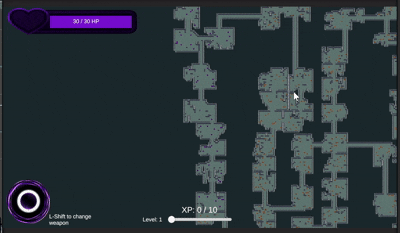Procedural Generation in 2D Systems (Unity)
Exploring algorithmic dungeon generation for replayable level design.
Demo Video
Overview
This project explored procedural generation methods to create dynamic, replayable dungeon layouts for 2D games. The study compared corridor-first and room-first algorithms, focusing on maintaining logical door connections, spawn areas, and pacing through automated spatial analysis.
My Role:
Implemented corridor-first and room-first algorithms
Designed door connectivity and spawn logic
Built BFS-based difficulty depth assignment
Tools Used
Unity (C#)
Tilemap System
BFS Pathfinding & Depth Metrics
Gizmos Debug Visualizer
Prototype Setup
The prototype generated connected dungeons using corridor and room prefabs. Each generation pass analyzed connectivity, room adjacency, and door overlap to ensure seamless traversal. BFS was used to assign depth tiers for difficulty scaling, allowing controlled enemy and loot distribution.
Methodology
To evaluate generation quality, multiple test iterations were conducted with variable map sizes, room densities, and connection thresholds. Metrics such as path connectivity, traversal distance, and room overlap were measured to ensure balance between randomness and structure.
Key Methods
Corridor-first and Room-first generation
BFS-based room depth scoring
AABB overlap avoidance
Portal door linking validation
Seed Input
Room Generation
Corridor Linking
BFS Depth Analysis
Results
The procedural generation framework produced 100% traversable maps in most cases, maintaining valid connections between all rooms. BFS-based depth analysis effectively balanced pacing and difficulty, showing consistent control over enemy and loot placement zones.
Key Statistics
100% connected dungeon success (post-validation)
<5% overlap rate (AABB collision)
Scalable structure up to 50 rooms
Takeaways and Conclusion
Procedural generation can successfully create replayable, balanced level structures when guided by spatial heuristics. The combination of deterministic BFS scoring with randomized layout input allows both structure and unpredictability — essential traits for modern roguelike and action games.
Lessons Learned
Structural constraints improve playability without reducing variety.
BFS depth systems enhance pacing and progression.
Hybrid approaches (semi-random seeding) yield the best results for balanced gameplay.





